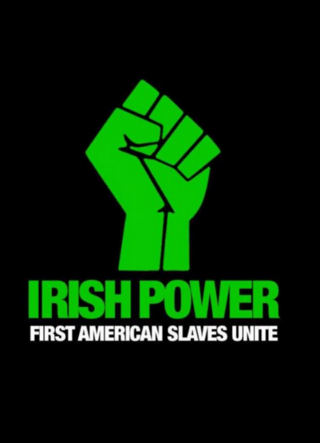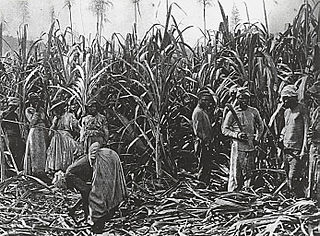Related Research Articles

Barbados is an island country in the Lesser Antilles of the West Indies, in the Caribbean region of North America, and is the most easterly of the Caribbean islands. It lies on the boundary of the South American and the Caribbean Plates. Its capital and largest city is Bridgetown.

Indentured servitude is a form of labor in which a person is contracted to work without salary for a specific number of years. The contract, called an "indenture", may be entered voluntarily for purported eventual compensation or debt repayment, or it may be imposed involuntarily as a judicial punishment. Historically, it has been used to pay for apprenticeships, typically when an apprentice agreed to work for free for a master tradesman to learn a trade. Later it was also used as a way for a person to pay the cost of transportation to colonies in the Americas.

The slave codes were laws relating to slavery and enslaved people, specifically regarding the Atlantic slave trade and chattel slavery in the Americas.

The Gullah are an African American ethnic group who predominantly live in the Lowcountry region of the U.S. states of South Carolina, North Carolina, Georgia, and Florida within the coastal plain and the Sea Islands. Their language and culture have preserved a significant influence of Africanisms as a result of their historical geographic isolation and the community's relation to their shared history and identity.
Bajan, or Bajan Creole, is an English-based creole language with African and British influences spoken on the Caribbean island of Barbados. Bajan is primarily a spoken language, meaning that in general, standard English is used in print, in the media, in the judicial system, in government, and in day-to-day business, while Bajan is reserved for less formal situations, in music, or in social commentary. Ethnologue reports that, as of 2018, 30,000 Barbadians were native English speakers, while 260,000 natively spoke Bajan.

The Barbados Slave Code of 1661, officially titled as An Act for the better ordering and governing of Negroes, was a law passed by the Parliament of Barbados to provide a legal basis for slavery in the English colony of Barbados. It is the first comprehensive Slave Act, and the code's preamble, which stated that the law's purpose was to "protect them [slaves] as we do men's other goods and Chattels", established that black slaves would be treated as chattel property in the island's court.

Sugar plantations in the Caribbean were a major part of the economy of the islands in the 18th, 19th, and 20th centuries. Most Caribbean islands were covered with sugar cane fields and mills for refining the crop. The main source of labor, until the abolition of chattel slavery, was enslaved Africans. After the abolition of slavery, indentured laborers from India, China, Portugal and other places were brought to the Caribbean to work in the sugar industry. These plantations produced 80 to 90 percent of the sugar consumed in Western Europe, later supplanted by European-grown sugar beet.

Slavery in the British and French Caribbean refers to slavery in the parts of the Caribbean dominated by France or the British Empire.

Barbadians or Bajans (pronounced BAY-jənz) are people who are identified with the country of Barbados, by being citizens or their descendants in the Barbadian diaspora. The connection may be residential, legal, historical or cultural. For most Barbadians, several of those connections exist and are collectively the source of their identity. Barbadians are a multi-ethnic and multicultural society of various ethnic, religious and national origins; therefore Barbadians do not necessarily equate their ethnicity with their Barbadian nationality.
The industrial heritage of Barbados, an island nation in the Caribbean, is exemplified by a number of specific structures still standing.
Robert Spencer Corruccini is an American anthropologist, distinguished professor, Smithsonian Institution Research Fellow, Human Biology Council Fellow, and the 1994 Outstanding Scholar at Southern Illinois University-Carbondale. As a medical and dental anthropologist, Corruccini is most noted for his work on the theory of malocclusion and his extensive work in a slave cemetery at Newton Plantation in Barbados.
Buckra or Backra is a term of West African origin. It is mainly used in the Caribbean and the Southeast United States. Originally, it was used by slaves to address their white owners. Later, the meaning was broadened to generally describe white people.

Black Barbadians or Afro-Barbadians are Barbadians of entirely or predominantly African descent.
Henry Hawley was the English Governor of Barbados from 1630 to 1639/40.

The Irish slaves myth is a fringe pseudohistorical narrative that conflates the penal transportation and indentured servitude of Irish people during the 17th and 18th centuries, with the hereditary chattel slavery experienced by the forebears of the African diaspora. Some white nationalists, and others who want to minimize the effects of hereditary chattel slavery on Africans and their descendants, have used this false equivalence to deny racism against African Americans or claim that African Americans are too vocal in seeking justice for historical grievances. It also can hide the facts around Irish involvement in the transatlantic slave trade. The myth has been in circulation since at least the 1990s and has been disseminated in online memes and social media debates. According to historians Jerome S. Handler and Matthew C. Reilly, "it is misleading, if not erroneous, to apply the term 'slave' to Irish and other indentured servants in early Barbados". In 2016, academics and Irish historians wrote to condemn the myth.

The Godet African Burial Ground is an unmarked historical burial ground for enslaved African men, women and children located at the southwest coast of Sint Eustatius, Dutch Caribbean. The burial ground was part of the former Godet plantation on the island.

The Golden Rock African Burial Ground is an unmarked historical burial ground of enslaved African men, women and children located on the premises of the airport on Sint Eustatius, Dutch Caribbean in the ‘Cultuurvlakte’. The burial ground was part of the former Golden Rock plantation on the island.

The plantations of Sint Eustatius were primarily set up in the seventeenth and eighteenth centuries by European settlers. Workers on the plantations were obtained from human trafficking, and the proceeds primarily went back to the mother country. In the second half of the eighteenth century, trade became more of a priority to Sint Eustatius rather than the plantation economy.

Golden Rock is the name of an archaeological site in the centre of the island of Sint Eustatius, Dutch Caribbean, named after a nearby former plantation. Golden Rock was the nickname of Sint Eustatius from its prominence as a major colonial trading port in the late 17th and early 18th century. The site contains the remains of a late Saladoid village, an African burial ground, and a village of enslaved Africans.
African diaspora archaeology is the study of the archaeology of the African diaspora; Africans that were forcibly transported throughout the world by either the Atlantic slave trade, the Trans-Saharan slave trade, the Indian Ocean slave trade, or their descendants. Although pertaining to worldwide dispersal, the majority of research comes from Africa and the Americas, with very little from Europe and Asia.
References
- 1 2 "Barbados Museum and Historical Society". Slavery and Remembrance. Retrieved 2022-02-28.
- 1 2 3 4 5 Shuler, K. A. (2011). "Life and death on a Barbadian sugar plantation: historic and bioarchaeological views of infection and mortality at Newton Plantation". International Journal of Osteoarchaeology. 21 (1): 66–81. doi:10.1002/oa.1108. ISSN 1099-1212.
- 1 2 3 4 5 6 7 8 9 10 11 Corruccini, Robert S.; Handler, Jerome S.; Mutaw, Robert J.; Lange, Frederick W. (1982). "Osteology of a slave burial population from Barbados, West Indies". American Journal of Physical Anthropology. 59 (4): 443–459. doi:10.1002/ajpa.1330590414. ISSN 1096-8644. PMID 6762099.
- 1 2 3 4 5 6 7 8 9 10 11 Handler, Jerome S.; Corruccini, Robert S. (1983). "Plantation Slave Life in Barbados: A Physical Anthropological Analysis". The Journal of Interdisciplinary History. 14 (1): 65–90. doi:10.2307/203517. ISSN 0022-1953. JSTOR 203517. PMID 11617355.
- 1 2 Handler, Jerome S.; Lange, Frederick W. (April 26, 1978). Plantation Slavery in Barbados: An Archaeological and Historical Investigation. Harvard University Press. ISBN 9780674332362.[ page needed ]
- 1 2 3 4 5 Handler, Jerome S. (1997-01-01). "Escaping slavery in a Caribbean plantation society : marronage in Barbados, 1650s-1830s". New West Indian Guide / Nieuwe West-Indische Gids. 71 (3–4): 183–225. doi:10.1163/13822373-90002605. ISSN 1382-2373.
- 1 2 3 4 Galenson, David W. (1982). "The Atlantic Slave Trade and the Barbados Market, 1673-1723". The Journal of Economic History. 42 (3): 491–511. doi:10.1017/S0022050700027935. ISSN 0022-0507. JSTOR 2120603. S2CID 154220595.
- 1 2 Roksandic, Mirjana; Alarie, Kaitlynn; Suárez, Roberto Rodríguez; Huebner, Erwin; Roksandic, Ivan (2016-04-12). "Not of African Descent: Dental Modification among Indigenous Caribbean People from Canímar Abajo, Cuba". PLOS ONE. 11 (4): e0153536. Bibcode:2016PLoSO..1153536R. doi: 10.1371/journal.pone.0153536 . ISSN 1932-6203. PMC 4829177 . PMID 27071012.
- 1 2 3 4 5 6 7 Handler, Jerome S. (1996-09-01). "A prone burial from a plantation slave cemetery in Barbados, West Indies: Possible evidence for an African-type witch or other negatively viewed person". Historical Archaeology. 30 (3): 76–86. doi:10.1007/BF03374222. ISSN 2328-1103. S2CID 163299265.
- 1 2 3 4 5 6 "Newton Plantation Collection". Lowcountry Digital Library. Retrieved 2022-02-04.
- ↑ Papers of the Newton Family. 1680–1920.
- ↑ "Newton Plantation Sugar Book 1849". Lowcountry Digital Library. Retrieved 2022-02-22.
- ↑ "Newton Plantation Slave List 1828". Lowcountry Digital Library. Retrieved 2022-02-22.